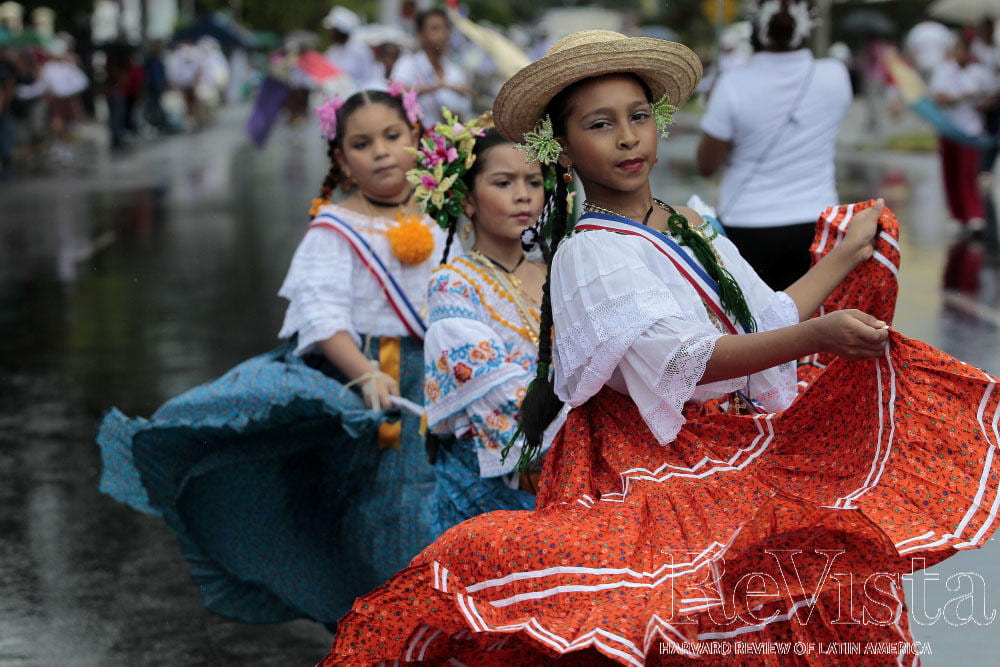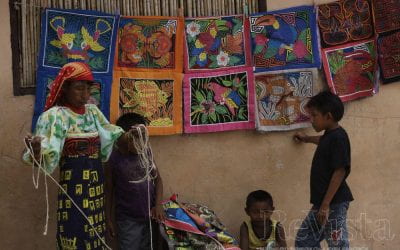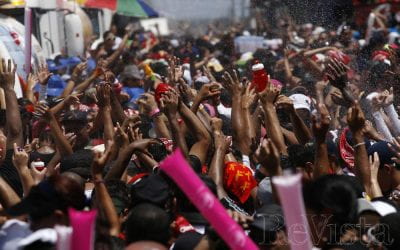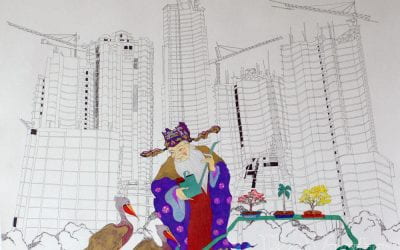Panamá and the United States
A Love-Hate Relationship
Marching bands in their colorful uniforms from schools all over Panamá fill the streets of the City for the November 3 Independence Day parades. Panamá is possibly the only country in the world that celebrates not one but three independence days every year. The people of Panamá have a strong sense of nationhood. The country’s complicated history has resulted in a love-hate relationship with the United States that eventually became an extraordinary foreign policy success for both countries.
Today, the Panama Canal Authority is completing a US$5.5 billion self-financed expansion program that will allow the transit of much larger ships. Both Republican and Democratic U.S. administration officials have publicly admitted: “Panamá is doing a much better job running the Canal than we did.” To understand the current situation, one must first understand a bit of history. In 1821, Panamá declared its independence from the Spanish Crown and in an effort to protect its nation voluntarily joined “The Great Colombia.” Those were many years of total abandonment by Colombia, including a congressional rejection of a treaty to assure the building of the Panamá Canal. In 1903, following the Thousand-Days’ War, a civil conflict in Colombia that also engulfed its Panamanian province, Panamá declared its independence from Colombia. This second revolutionary act was successful in part because of the support of United States gunships off the coast (similar to the French support of U.S. revolutionaries in 1776)….thus the love part of the Panamá-U.S. relationship. In the following days a very well-connected and shrewd Frenchman, Philippe Bunau-Varilla, involved in the failed French Panama Canal project, hastily signed (hours before the official Panamanian delegation arrived in Washington, D.C.) a U.S.-Panama Treaty granting the U.S. a “Panamá Canal Zone,” ten miles wide across the center of the Isthmus, to be governed by the United States “as if it were sovereign…” in perpetuity”. A treaty that no Panamanian ever signed laid the basis for the “hate” part of the Panamá-U.S. relationship. Ninety-five years later, this ominous treaty was annulled and new reasonable treaties were put into place. Panamá again was sovereign in all of its territory, taking control of the Panama Canal. Thus, the Panamá-U.S. relationship swung back to its “love” part …and Panamá’s third independence. To the credit of the non-violent tradition of the Panamanian people, the first two independences were achieved through intelligent negotiation without spilling one drop of blood. In the third and final independence, shooting started from the U.S. side.
EFFORTS AT REFORM OR REVISION OF TREATIES
Since the very beginning of the Hay-Bunau Varilla Treaty, the Panamanian people objected to the one-sided document and began their national struggle to reform the treaty and the Panamá-U.S. relationship. On the U.S. side, the Canal Zone government was assigned to the U.S. military with an Army General appointed governor of the area, making the relationship that much more difficult. The Panama Canal Zone became the perfect colony. The United States owned all lands; no private businesses were allowed, all employees were U.S. government-employed, who lived in government housing, shopped in government commissaries, were educated in government schools, went to government theaters, and learned to live behind protective high chain link fences, psychologically isolating them from Panamá and its citizens. Jobs for U.S. citizens in the Canal Zone were inherited from generation to generation so that these people no longer felt the United States was “home.” Nor did these Zonians feel Panamá was home either; they were colonialists in the full sense of the word. The Canal Zone’s salary system had gold and silver levels: U.S. citizens were gold, and Panamanians were silver, earning much lower pay for equal work, thereby becoming second-class citizens in their own country. These disparities reinforced the hate part of the relationship between the United States and Panamá.
Panamá’s efforts to negotiate changes to the 1903 Treaty continued, but it was not until 1936 that then-Panamanian President Harmodio Arias achieved some adjustments to the treaties. The next adjustments took place in 1955 when both countries had military men as presidents: José Antonio Remón and Dwight D. Eisenhower.
In 1960 President Lyndon Johnson, in order to relieve tensions between the two countries, gave the order to fly the Panamanian flag next to the Stars and Stripes in the U.S.-governed Canal Zone.
THE 1964 CRISIS
In a fury, “Zonians” rejected the Johnson order and even took down U.S. flagpoles to avoid flying the Panamanian flag. This exacerbated the resentment of all Panamanians towards the “Zonians” and the United States.
Finally, after Zonians had refused to comply with the presidential order for four entire years, a small group of Panamanian National Institute high school students marched toward Balboa High School in the Canal Zone to raise the Panamanian flag on the empty flagpole next to the U.S. flag. The high school students, intending to carry out the U.S. President’s order, were attacked by “Zonians” in full view of Canal Zone policemen. Their Panamá flag was torn to shreds; The students ran for their lives back to “the border,” the Panamanian side of the zone. The news spread like wildfire and thousands of Panamanians gathered at “the border,” and the Canal Zone governor ordered the U.S.Army to the border. Shooting erupted against largely unarmed Panamanians. The casualty count was lopsided: 21 people were killed on the Panamanian side, while on the U.S. side, four U.S. Army personnel lost their lives. Panamanian President Roberto F. Chiari—responding to the outcry of his people—took the dramatic step of severing diplomatic relations with the United States. This marked a first in Latin America, since even in the case of Cuba, it had been the United States that broke with Cuba, not the other way around.
Chiari called on Miguel J. Moreno, a prestigious political adversary, who would become Panamanian Ambassador to the Organization of American States, to firmly present Panamá’s denunciations of the U.S. attack.
An agreement, the Moreno-Bunker document, was finally reached, completely changing the relationship between the two countries. Instead of the revisionist doctrine stubbornly held onto by the United States in regard to the 1903 one-sided treaty, the agreement called for the start of negotiations of a completely new Panamá-U.S. treaty, which would mark the beginning of a new relationship.
A NEW RELATIONSHIP—PLUSES AND MINUSES
Unbeknownst to Panamá and Panamanians, a Georgia peanut farmer named Jimmy Carter, who had become the U.S. Democratic presidential candidate, had prioritized the fixing of “the Panamá problem” to prove that the United States— the world power—could negotiate face-to-face with a small and weak county, thus guaranteeing the safety of a world-class asset, the Panama Canal. It also helped that the U.S. Defense Department had decided earlier that the Panama Canal was militarily indefensible. That meant that the security of the Canal depended on peace in Panamá and the maintenance of Canal neutrality in regards to Canal shipping access. All of these pluses became vital to the final outcome of the new Panamá-U.S. negotiations.
The minus part, however, is that Panamá was then ruled by Gen. Omar Torrijos, Panamá’s first military dictator. Carter—supposedly the “human rights president”—was put in the position of negotiating with a military dictator, a situation that was very disturbing to Panamá’s democrats (myself included). Under the Torrijos dictatorship, many of Panamá’s civic opposition members of all political and ideological persuasions were arrested and forcefully exiled from their country, an act expressly prohibited the Panamanian Constitution, to say nothing of disappearances and serious allegations of persecution and murder.
After the 1964 riots, Panamá endured 13 years of frustrating negotiations with consecutive U.S. governments. Finally, the Torrijos-Carter Treaties were signed and submitted for legislative approval of both countries. In a very hostile environment, President Carter personally campaigned for U.S. Senate approval. Opposition to Carter stubbornly repeated “the Canal is ours, we built it, and we will not permit that it be given away” mantra. The Senate vote-counting came down to single digits, which was not going to be made any easier with Panamanian political exiles walking the halls of the Senate, describing the horrors committed by the Torrijos regime. To whitewash the uncomfortable facts about the dictatorship, Carter got Torrijos to agree to the return of all political exiles. The brief period in which the Torrijos dictatorship put on a gentler face—for Washington’s benefit—is known as the “democratic Spring” (veranillo democrático) amongst Panamanians.
In Washington the strategy worked, and the Torrijos-Carter Treaties were confirmed by a one vote margin in the Senate. In Panamá, however, they went to referendum in the absence of political parties or a free press, and were “approved” by 67 percent of the population in a 96 percent turnout.
The treaties called for the transfer of the Canal to Panamá in 22 years (at 12 noon Dec. 31, 1999), which then seemed like an eternal wait…but the date finally arrived.
THE NORIEGA YEARS
Meanwhile the so-called “democratic spring” came to a screeching halt in the early 1980s. General Omar Torrijos died in a plane crash in 1981, and after much infighting within the Panamanian military, Manuel Antonio Noriega became the strongman-in-charge. Noriega had run the G-2 Intelligence under Torrijos, who in military circles referred to Noriega as “my gangster.” Noriega had been a CIA asset from the age of 18. His longtime CIA handler Nestor Sánchez was given a Defense Department contract when he retired because of his ties to Noriega. Noriega openly dealt with the Colombian drug mafias and handled the government’s budget as his personal petty cash. Under Noriega, Panamá was rapidly becoming the first country in the world controlled by the drug mafias.
In 1986, a member of Noriega’s High Command broke with him when Noriega reneged on a promise to award him an ambassadorship and publicly confessed all the sins of the military brass, ranging from the murder of opposition leaders and stealing elections, among other crimes. The newspaper La Prensa published these revelations and the public outcry gave birth to the Cruzada Civilista (Civilian Crusade)—which paralyzed the country, including shutting down the banks. Noriega lost all capability to govern and turned aggressively violent against the Panamanian people.
By the next year (1987) with the Panamanian people protesting daily in the streets, what to do with Noriega became a major U.S. dilemma. An inter-agency crisis team on Panamá was in total disarray. The CIA continued supporting Noriega, stating “he is our SOB;” the DEA protected him with statistics of drug interdiction in Panamá (actually becoming Noriega’s “enforcer” whose tactic with drug runners was “you don’t pay, I hand you over to the DEA).”)Strangely, the State Department was the hawk and the Defense Department was the dove. The White House was at a loss…until Noriega made the mistake of killing a U.S. soldier.
As a result, in 1989, President George H. W. Bush decided to invade Panamá, taking Noriega out without informing the CIA (as a former CIA director, Bush knew of the Noriega-CIA relationship). The invasion was extremely costly in lives and property, but Noriega was arrested, tried and convicted in a U.S. court for drug trafficking; after serving 17 years in prison in the United States and four years in France for money laundering, he now sits in a Panamanian jail under a 20-year sentence for the murder of many Panamanians. The Panamanian military was decimated by the U.S. invasion and Panamá approved a constitutional amendment, declaring itself a demilitarized and neutral nation.
The United States carried out the invasion with an almost immediate exit strategy. Fortunately, Panamá had recently held a presidential election won by the opposition (and annulled by Noriega), so Panamá had a legitimately elected civilian government in place which took office after the invasion. Since democracy had been Panamá’s traditional political system, and dictatorship had only been a once-only prolonged parenthesis, the country immediately went back to its democratic roots and normalized relations with the United States.
Because Noriega had been considered to be supported by the United States (again “hate”), the invasion to take him out was considered a liberation by the majority of the Panamanian people (a swing to the “love” part of the Panamá-U.S. relationship). Polling shows Panamá today as the most pro-U.S. country in the hemisphere.
THE CANAL TURNOVER
Throughout the years leading up to the turnover, a plan to employ Panamanians in executive positions at the canal and as canal pilots was seriously implemented in an effort to make the turnover imperceptible to canal clients (the world’s shipping industry). At the beginning of the transition, the Canal Administrator was American and the sub-Administrator Panamanian. The Board of Directors was made up of five Americans and four Panamanians with a U.S. chairperson. Gradually, proportions shifted to the point when the administrator was Panamanian (Gilberto Guardia F.) and Panamanians held a majority of the board. Finally, the old U.S. Canal Commission was dissolved and replaced by the newly formed Panama Canal Authority (an autonomous agency of the Panamá government).
Since Panamá had to create legislation for the canal, with the assistance of the United Nations Development Programme (UNDP), representatives of all sectors of Panamanian society participated in the initiation of a national consensus. All political parties (government and opposition) participated, achieving consensus agreements to include the Panama Canal in the Constitution. Legislation was created to guarantee the independence of the canal organization to protect it from political interests. Consensus agreements with regards to zoning of the Panama Canal Zone were also achieved, as on December 31, 1999, the geography of Panama City would duplicate in size.
Panamanians are known for their political differences, but throughout the consensus process, they came together as a people of one nation. The general feeling was “we won’t allow anyone to play politics with our Canal.”
THE RESULTS
When the world superpower transfers a major international asset to a small young country, the obvious generalized feeling is one of zero credibility. When the canal was turned over to Panamanians, much of the world opinion believed that Panamá most probably would not be capable of managing it.
Zero credibility was a major problem, but at the same time a major opportunity. If Panamá did it right, it would surprise the world and positive opinion would have an exponential impact.
That is exactly what has happened: the canal transfer was imperceptible to world shipping. The canal organization shifted from a military bureaucracy to an efficient profit-centered autonomous government organization. Under U.S. administration, the canal had only one objective: passing ships from one ocean to another. Under Panamanian administration, by contrast, the Canal Authority has permitted the development of four world-class Ports, the modernization of the Panamá Canal Railroad, the development of tourism and many other complementary activities.
The Panama Canal Authority has launched a self-financed widening expansion project worth US$5.5 billion, to be inaugurated in 2014-2015. This expansion will allow the transit of much larger ships (known to canal users as “post Panamax”). A majority of the Panamanian people approved this expansion in a national referendum.
Many U.S. high level government officials of both Democratic and Republican administrations have visited the Panamá-owned canal and have publicly declared that it’s running better than ever.
Not too long ago a good friend from New York came to visit me. It was his first visit to Panamá. As I took him around the city sights, he was constantly exclaiming “I never expected this!” Then I said “now I’m going to take you to see something that will make you very proud to be an American, and makes me very proud to be a Panamanian.”
I gave him a tour of the Panama Canal; he saw the organization, the widening project, and how the original engineering still works wonders. When we were driving away, he became very emotional, declaring “you were so right: I feel so proud…
as you do. You know, this has to be the most successful peaceful foreign policy achievement in the history of the U.S…it’s a shame the great majority of Americans don’t even know about it.”
Spring 2013, Volume XII, Number 3
Roberto Eisenmann is the founder of the Panamanian daily La Prensa. A 1986 Nieman Fellow at Harvard, he was honored with a lifetime achievement award by Fundación Fórum de Periodistas por la Libertad de Expresión e Información of Panamá for his continued commitment to freedom of expression and information. After his Nieman fellowship, Eisenmann was exiled from Panamá a second time due to reprisals from the Noriega regime.
Related Articles
The Panamanian Novel
Pueblos perdidos, the novel which earned Gil B. Tejeira Panamá’s Miró Literary Prize for 1963, tells the story of Gatún Lake, at the time the largest artificial…
Panamanian Culture
Panamanian culture has roots in at least three continents. It’s a heterogeneous culture, embracing elements from various communities that coexist peacefully…
Panama City
On May 8, 2003, the Bay of Panamá suddenly turned red. The Coca-Cola factory had spilled a massive amount of non-toxic red chemical dye and was eventually…





